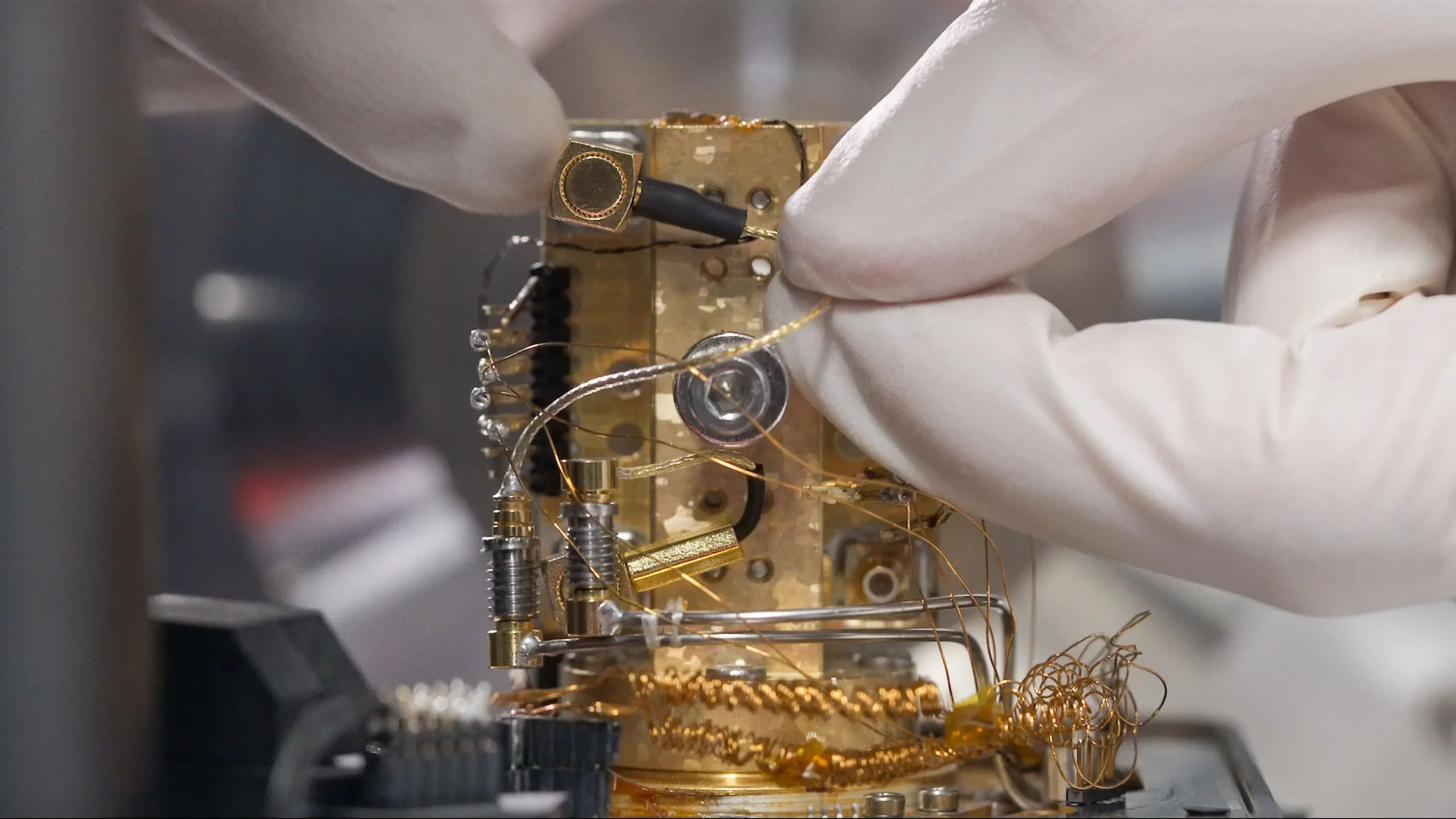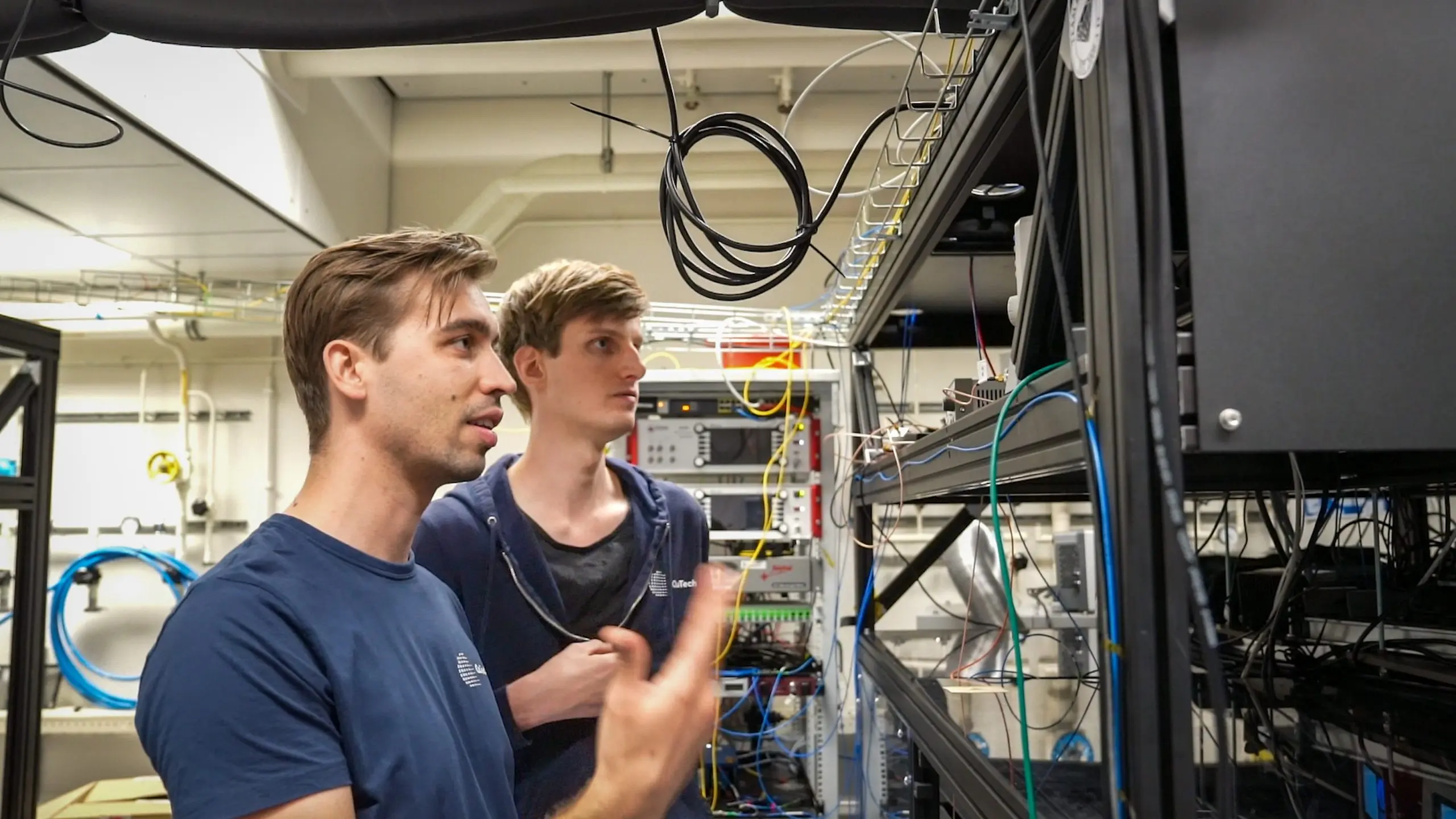Researchers at QuTech established a connection between two quantum processors ten kilometers apart using standard fiber optic cable. They see this as an important step toward a quantum internet.
Researchers Kian van der Enden and Arian Stolk at the connection point halfway between qubits in The Hague and Delft. (Photo: QuTech)
An international team led by Prof. Ronald Hanson of QuTech – a collaboration between TU Delft and TNO – has succeeded in connecting two small quantum processors located in Delft and The Hague.
“The distance over which we create quantum entanglement in this project, via 25 kilometres of existing underground fibre optic cable, is a record for quantum processors,” says Hanson. “This is the first time quantum processors in different cities have been connected.”
Non-hackable
In this case, the quantum processors are diamond qubits controlled by laser pulses, though they could just as well be quantum computers. When photons from both qubits are entangled at the midpoint node, the qubits themselves become entangled, establishing a quantum link between them. This means the qubits are in a state of instant contact which cannot be eavesdropped on.
Nearly 10 years ago, Hanson and his colleagues made international news with a quantum link between two qubits on campus: one in the Applied Physics building and the other a kilometre away at the research reactor, with a midpoint node at the Electrical Engineering, Mathematics and Computer Sciences building. They demonstrated that information exchange between the entangled qubits was faster than light – a phenomenon previously thought impossible. None other than Einstein had declared it so.
Physics, Einstein said, is based on locality – the principle that something can only be influenced by something in its immediate surroundings. Remote interaction can never occur faster than the speed of light. Entanglement contradicts this, as it enables instantaneous interaction at a distance.
Precision

What is the difference then between the 1 kilometre link back then and the 10 kilometre link now? For starters, it’s a significant leap in technology. While entanglement was achieved approximately every half hour back then, today it occurs about once a minute over 25 kilometres of underground fibre optic cable. PhD candidates Kian van den Ende and Arian Stolk, along with Hanson, have documented these findings in Science Advances. They are the lead authors of the study, joined by 20 other contributors.
Van den Ende and Stolk pulled off an impressive technical feat with their fibre optic connection. For entanglement to occur, photons from both sides must arrive at the midpoint node in the same phase. . Achieving this requires incredible timing precision, with a path difference limited to 100 nanometres over 25 kilometres of fibre.
Stolk does a comparison. “This challenge is similar to maintaining the distance between the Earth and the Moon with an accuracy of just a few millimetres. By combining learnings from research with applied engineering, we were able to solve this puzzle.”
Conversion
In 2015, 1 kilometre was the maximum distance a qubit photon could travel through fibre optics. Now, using a laser and a crystal, a qubit photon is converted into a different photon that has the optimum wavelength for fibre optics. Remarkably, the quantum properties of the photon remain intact during this conversion. Without this conversion, bridging 25 kilometres of fibre optic would be impossible, Hanson explains.
Scaling Up
“Now we need to increase the speed,” says Hanson, who has plans in place for doing so. “We aim to use a different type of qubit with 100 times less light loss . Additionally, we’ll be multiplexing. Thousands of signals can travel simultaneously through a fibre optic cable. That’s what we’ll do instead of sending one signal at a time and waiting for confirmation of the connection.”
Maximum privacy
Combining improved light efficiency with multiplexing would make it possible to establish entangled connections remotely 100,000 times faster than now. This step is essential, as practical applications of quantum systems will require dozens or even hundreds of functional qubits.
If they manage to link these, it will mean a huge advance in computing power. Because unlike conventional computers, the computing power of quantum computers does not increase linearly with the number of processors but exponentially. “So, two large quantum computers together (through a quantum connection) are far more powerful than both separately,” Hanson explains in a QuTech video.
This is one facet of the future quantum internet, the foundation of which has now been laid. The other is the storage and processing of data in the cloud through non-hackable connections that guarantee maximum privacy.
QuTech video: Quantum internet made real
New Quantum Computer in Amsterdam
Another development in the world of quantum technology. Two weeks ago, the European Union High Performance Computing Undertaking (EuroHPC JU) has selected SURF at Amsterdam Science Park as a new location for a state of the art EuroHPC quantum computer. The plan is to link it to the existing supercomputer, Snellius, which is already there. The upcoming Amsterdam-based quantum computer will use semiconductor spin qubits. With a minimum of 16 physical qubits, the system won’t be extremely powerful just yet. Computer scientists are exploring the potential of combining a supercomputer with a quantum computer, with high hopes for tackling optimisation challenges, like improving urban traffic flow or simulating molecular structures—essential for the development of new medicines and materials. (KB/JW)

Do you have a question or comment about this article?
j.w.wassink@tudelft.nl


Comments are closed.